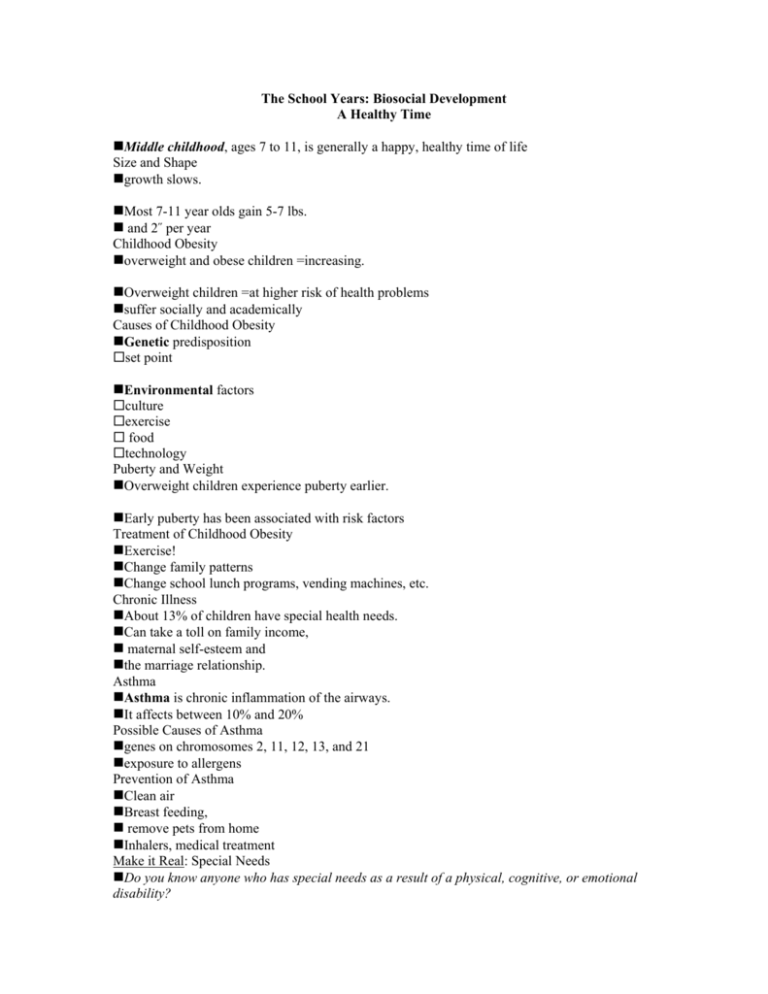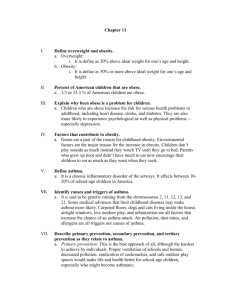The School Years: Biosocial Development
advertisement

The School Years: Biosocial Development A Healthy Time Middle childhood, ages 7 to 11, is generally a happy, healthy time of life Size and Shape growth slows. Most 7-11 year olds gain 5-7 lbs. and 2˝ per year Childhood Obesity overweight and obese children =increasing. Overweight children =at higher risk of health problems suffer socially and academically Causes of Childhood Obesity Genetic predisposition set point Environmental factors culture exercise food technology Puberty and Weight Overweight children experience puberty earlier. Early puberty has been associated with risk factors Treatment of Childhood Obesity Exercise! Change family patterns Change school lunch programs, vending machines, etc. Chronic Illness About 13% of children have special health needs. Can take a toll on family income, maternal self-esteem and the marriage relationship. Asthma Asthma is chronic inflammation of the airways. It affects between 10% and 20% Possible Causes of Asthma genes on chromosomes 2, 11, 12, 13, and 21 exposure to allergens Prevention of Asthma Clean air Breast feeding, remove pets from home Inhalers, medical treatment Make it Real: Special Needs Do you know anyone who has special needs as a result of a physical, cognitive, or emotional disability? Examples: ADHD, autism, learning disability, physical disability, etc. Children with Special Needs Children who require extra help in order to learn have “special needs.” Examples: pervasive developmental delays, learning disabilities, attention deficits, autism, physical disability, emotional impairment, and more. Pervasive Developmental Delays Pervasive developmental disorders are severe problems, such as autism, that affect many aspects of a young child’s psychological growth, causing evident delay of speech, movement, or social skills before age 6 years. Autism Autism is a PDD characterized by an inability to relate to other people normally, including extreme self-absorption, and an inability to learn normal speech. The level of severity of symptoms varies across individuals (e.g. Asperger syndrome represents high functioning). Symptoms of Autism CORE SYMPTOMS: Absent of abnormal language Social aloofness or unawareness Repetitive, asocial play Undersensitive to pain Oversensitive to noise Insistence on routine Possible Causes of Autism Genes Teratogens Thimerosal, found in immunizations, has been repeatedly accused but consistently disproved as a factor) Viruses, infections, pesticides, or drugs Better diagnosis today Treatment of Autism Early intervention is beneficial One-on-one behavioral training teaching social play strategies and language skills Encouraging social connections Examples: rewards for eye contact, interacting Treatment for Autism (cont.) This teacher is trying to facilitate eye contact and encourage this 4 year old child with autism to speak. Learning Disability A marked delay in a particular area of learning not associated with any physical handicap, mental retardation, or unusually stressful home environment. Dyslexia Dyslexia = difficulty with reading May “guess” at reading Problem may involve auditory processing of sounds Has a huge effect on self esteem Attention Disorders ADD and ADHD are both neurological disorders involving difficulty screening out irrelevant stimuli. Possible causes: abnormality in brain or neurotransmitters, or prenatal damage (teratogens), genetic vulnerability (boys more susceptible), or postnatal damage (lead) Attention Deficit Disorder (ADD) Difficulty concentrating Prone to anxiety and depression May seem lost in thought, “spaced out” Increased risk of developing conduct disorder or oppositional defiant disorder Attention Deficit Hyperactivity Disorder (ADHD) Difficulty concentrating for more than a few minutes at a time: inattentive, impulsive, overactive Increased risk of developing conduct disorder or oppositional defiant disorder Treatment of Attention-Deficit Disorders Medication (e.g., Ritalin, Adderall, Strattera) Behavioral Modification Training for parents and teachers Educating Children with Special Needs Least restrictive environment (LRE)— legally required school setting that offers children with special needs as much freedom as possible to benefit from the instruction available to other children. Educating Children with Special Needs (cont.) Children with special needs are guaranteed an Individual Education Plan (IEP). Legal document It specifies a series of educational goals, and services required Educating Children with Special Needs (cont.) Mainstreaming—special needs kids in the general classroom Resource Room: separate room with a trained special-education teacher Inclusion: child in general classroom but with paraprofessional








